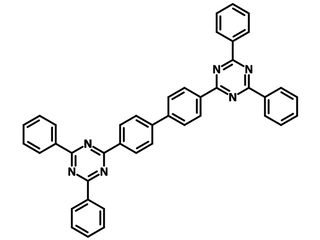BTB
CAS Number 266349-83-1
Charge Transport Layer Materials, Electron Transport Layer Materials, High Purity Sublimed Materials, Host Materials, Materials, OLED Materials,BTB, ETL material in highly efficient OLED devices
Phosphorescent host material for green and red LEDs. 4,4'-bis(4,6-diphenyl-1,3,5-triazin-2-yl)biphenyl, CAS No. 266349-83-1, Sublimed ≥99.0%
BTB is used as an electron-transport material in organic light-emitting devices (OLEDs) due to its electron deficiency from the two triazine units.
With electron mobility greater than 10−4 cm2V−1 s−1, BTB demonstrates an electron mobility 10-fold greater than that of the widely-used material tris(8-hydroxyquinoline) aluminum (Alq3). OLEDs incorporating BTB as the electron transport layer exhibit lower driving voltages and higher efficiencies - relative to those incorporating Alq3.
BTB, like other electron-deficient materials (such as T2T), can be used as a phosphorescent host material for green and red light-emitting diodes.
General Information
| CAS number | 266349-83-1 |
|---|---|
| Full name | 4,4'-bis(4,6-diphenyl-1,3,5-triazin-2-yl)biphenyl, 4,4'-bis-[2-(4,6-diphenyl-1,3,5-triazinyl)]-1,10-biphenyl |
| Chemical formula | C34H28N6 |
| Molecular weight | 520.62 g/mol |
| Absorption | n.a. |
| Fluorescence | n.a. |
| HOMO/LUMO | HOMO = 6.18 eV, LUMO = 2.14 eV [1] |
| Classification / Family | Triazine derivatives, Electron-transport layer (ETL) materials, Hole-blocking layer (HBL) materials, TADF materials. |
Product Details
| Purity | Sublimed > 99% (LCMS) |
|---|---|
| Melting point | 362 °C (lit.); Tg = 137 °C |
| Appearance | White crystals/powder |
Chemical Structure

Device Structure(s)
| Device structure | Al/NPD (40 nm)/CPCBPTz*:Ir(mppy)3 (10 vol.%, 30 nm)/BTB (30 nm)/LiQ (0.8 nm)/Al (80 nm) [1] |
|---|---|
| Color | Green |
| Max. Power Efficiency | 25.5. ± 9.1 lm W−1 |
| Max. Current Efficiency | 20.3 ± 6.6 cd/A |
| Max. EQE | 8.2 ± 0.9% |
| Device structure | Al/NPD (40 nm)/CPCBPTz*:Ir(mppy)3 (10 vol.%, 15 nm)/BCzPh:Ir(mppy)3 (10 vol.%, 15 nm)/BTB (30 nm)/LiQ (0.8 nm)/Al (80 nm) [1] |
|---|---|
| Color | Green |
| Max. Power Efficiency | 23.8 ± 3.6 lm W−1 |
| Max. Current Efficiency | 15.4 ± 0.8 cd/A |
| Max. EQE | 8.5 ± 0.4% |
| Device structure | ITO/NPB (60 nm)/Alq3:0.6 wt% C545T (15 nm)/BTB (45 nm)/Mg:Ag [2] |
|---|---|
| Color | Green |
| Max. Power Efficiency | 10.18 lm W−1 |
| Max. Current Efficiency | 10.53 cd/A |
MSDS Documentation
Literature and Reviews
- Mapping Recombination Profiles in Single-, Dual-, and Mixed-Host Phosphorescent Organic Light Emitting Diodes, P. Kuttipillai et al., Org. Electron., 57, 28-33 (2018); 10.1016/j.orgel.2018.02.025.
- High electron mobility triazine for lower driving voltage and higher efficiency organic light emitting devices, R. Klenkler et al., Org. Electron., 9, 285–290 (2008); doi: 10.1016/j.orgel.2007.11.004.
- 1,3,5-Triazine derivatives as new electron transport–type host materials for highly efficient green phosphorescent OLEDs, H. Chen et al., J. Mater. Chem., 19, 8112–8118 (2009); DOI: 10.1039/b913423a.
